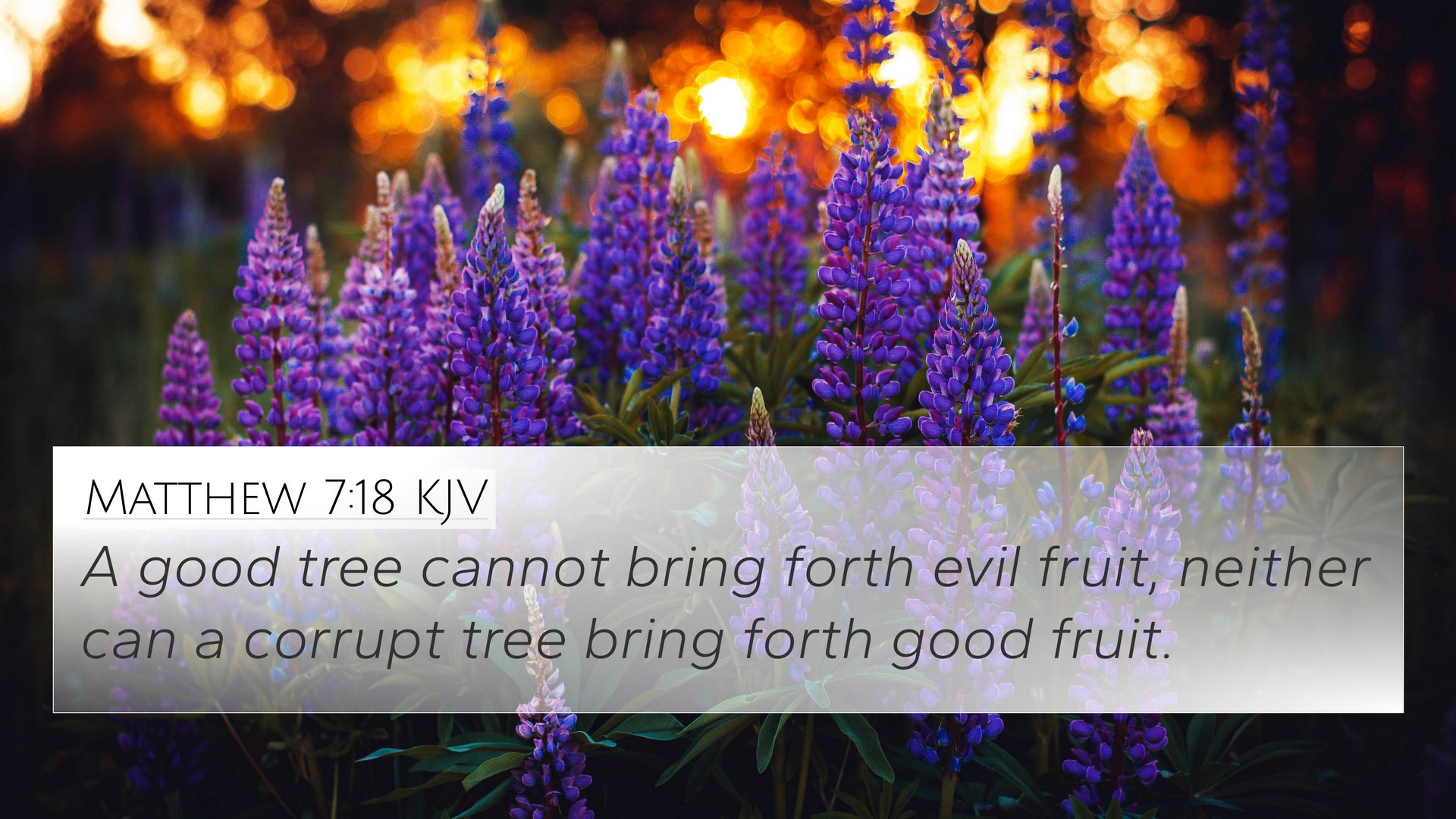Meaning and Interpretation of Matthew 7:18
Bible Verse: Matthew 7:18 - “A good tree cannot bring forth evil fruit, neither can a corrupt tree bring forth good fruit.”
Summary of Interpretations
This verse from the Gospel of Matthew emphasizes the intrinsic relationship between a person's nature and their actions. The metaphor of trees producing fruit illustrates that the moral quality of a person's life can be assessed by the outcomes of their behaviors. This teaching resonates through various themes found in Scripture, reflecting the idea that true goodness and righteousness come from a genuine inner transformation.
Key Themes Explained
- Nature and Actions: As Matthew Henry suggests, good fruits are the natural result of a good tree. This highlights that external actions are indicators of internal character.
- Discernment in Judgment: Albert Barnes points out that this verse teaches the necessity of discernment in evaluating one's character and the character of others, especially leaders and teachers.
- Integrity of Character: Adam Clarke stresses that integrity manifests through a consistent moral output, which is either good or corrupt based on one’s inner state.
Bible Verse Cross-References
- Luke 6:43-45: Discusses the principle of good fruit coming from good trees, reinforcing the teaching found in Matthew.
- Galatians 5:22-23: Highlights the "fruit of the Spirit," which reflects a good internal state.
- James 3:12: Questions whether a fig tree can produce olives, illustrating the impossibility of contradictory outputs.
- Matthew 12:33: Suggests that trees can be recognized by their fruit, elaborating on moral and ethical evaluations.
- Proverbs 4:23: Urges the guarding of one's heart, as it influences one's actions and ultimately yields fruit.
- John 15:5: Jesus speaks about being the vine and how branches must be connected to bear good fruit, indicating dependence on Him for righteousness.
- Philippians 1:11: Paul mentions being filled with the fruits of righteousness, linking character to outcomes in a believer's life.
Understanding Connections Between Bible Verses
Linking Bible scriptures can deepen one’s understanding of individual verses. Matthew 7:18 can be studied alongside passages that discuss the nature of righteousness and the moral law, presenting a comprehensive view of biblical ethics. By cross-referencing these verses, believers can see a coherent narrative that underscores the importance of character in the Christian life.
Comparative Bible Verse Analysis
Thematic Bible verse connections are foundational in developing a robust theological framework. By analyzing the parallels with Galatians 5, which speaks about the fruits of the Spirit, and contrasting them with the examples of corrupt fruit in other Scriptures (like Romans 1:29-31), one can better grasp the biblical understanding of good and evil through a comparative lens. This approach is supported by the tools available in a Bible concordance or cross-reference Bible study guides.
How to Use Bible Cross-References
For those learning how to find cross-references in the Bible, it's beneficial to employ a Bible cross-reference guide for directed study. Searching for similar themes in different books can reveal the interconnectedness within Scripture. For example, the interplay between Old Testament prophecies and New Testament fulfillments can illustrate the consistency of God's message across different eras.
Example Study Method:
- Choose a foundational verse, such as Matthew 7:18.
- List cross-references that align with the themes found in that verse.
- Explore each reference in context, noting thematic parallels and contrasts.
- Summarize insights gained from the comparative analysis.
Conclusion
Understanding Matthew 7:18 in the light of cross-referencing helps believers discern the essence of Christian morality. Engaging with the Scriptures through a lens of interconnectedness establishes a clearer vision for living out one’s faith. Through tools like Bible concordances and cross-reference study methods, Christians can find deeper meanings and applications of verses that resonate with their lives.
Relevant Keywords
This exploration into the meaning of Matthew 7:18 has incorporated various keywords relevant to understanding cross-references in the Bible:
- Bible verse cross-references
- Connections between Bible verses
- Comparative Bible verse analysis
- Cross-referencing Biblical texts
- Bible verses that relate to each other
- Tools for Bible cross-referencing
- Bible reference resources




